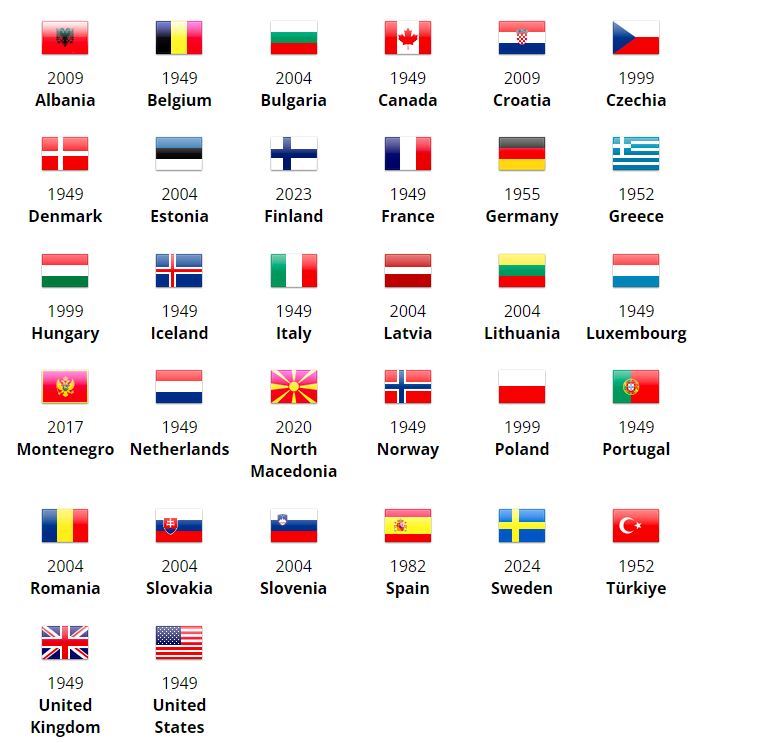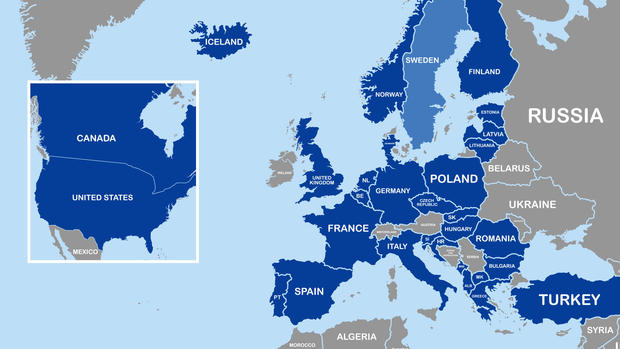Table of Contents
NATO has urged a 400% boost in defence spending to tackle rising threats from Russia, with a proposed 3.5% of GDP for military and 1.5% for related infrastructure, ahead of the June 24–25 NATO Summit.
The North Atlantic Treaty Organisation (NATO) is a political and military alliance consisting of countries from North America and Europe. Founded in 1949, NATO’s primary goal is to ensure collective security and stability among its member nations. As of 2025, NATO continues to expand and adapt to global challenges. This article provides a comprehensive NATO countries list for 2025, details about the member nations, and a map showcasing their geographical locations.
NATO Summit 2025 in Hague
The NATO Summit 2025 is scheduled to take place in The Hague, Netherlands, from June 24 to 25, 2025. It is a momentous occasion as it is the first time the Netherlands is hosting a NATO Summit in its history since the formation of the alliance in 1949. The summit is being conducted at the World Forum conference centre.
Historic Significance
- First-time Host: The Netherlands, being one of the founding members of NATO, hosts its very first summit.
- New Secretary General: Mark Rutte, the new Secretary General of NATO, and a former Prime Minister of the Netherlands and native of The Hague, is inaugural at this summit.
Key Agenda Topics of NATO Summit 2025
- Expected to be a new defence spending target
- Continued unwavering support for Ukraine in its war against Russia
- Need to ramp up defence industrial production across NATO
- Making decisions to strengthen collective defence, making NATO a stronger, fairer, and more lethal alliance
- Addressing contemporary threats, including hybrid warfare, cyberattacks, critical infrastructure sabotage, and the implications of emerging and disruptive technologies
- Strengthening partnerships with non-NATO members
What is NATO?
NATO (North Atlantic Treaty Organization) is an intergovernmental military alliance formed to promote peace and security among member states. The NATO Alliance operates under the principle of collective defense, meaning that an attack on one member is considered an attack on all (Article 5 of the NATO Treaty).
| Aspect | Details |
| Founded | 1949, with the signing of the North Atlantic Treaty (Washington Treaty) to counter Soviet expansion in post-World War II Europe. |
| Headquarters | Brussels, Belgium |
| Nature | Military & political alliance of 32 countries from Europe & North America. |
| Core Principle | Collective Defense (Article 5): An attack on one NATO country is considered an attack on all. Invoked only once after the 9/11 attacks (2001). |
| Founding Members (12) | Belgium, Canada, Denmark, France, Iceland, Italy, Luxembourg, Netherlands, Norway, Portugal, UK, USA. |
| Latest Expansion | Finland joined NATO in 2023. |
| Ukraine’s NATO Bid | Applied in 2022, received security assurances at Vilnius Summit (2023). |
| Non-NATO EU Members | Austria, Cyprus, Ireland, and Malta. |
Key Objectives of NATO
- Collective Defense: Protect member nations against external threats.
- Crisis Management: Handle conflicts through diplomatic and military means.
- Cooperative Security: Strengthen partnerships with non-member nations.
- Deterrence & Defense: Maintain military readiness and modernisation.
NATO Full Form
North Atlantic Treaty Organisation is the Full form of NATO. The main objective of NATO is to protect the independence and security of the Allies via political and military action.
NATO Member Countries in 2025
NATO continues to be the transatlantic community’s major security tool and a representation of its shared democratic values. It serves as a realistic link that binds North American and European security together indefinitely. NATO enlargement has furthered the U.S. vision of a Europe whole, free, and at peace. The North Atlantic Treaty Organisation (NATO) countries list 2025 consists of 32 countries, of which 12 founder Countries joined the list in 1949, and 19 other countries then joined the list one by one.

NATO Countries List with their Capital City
There are a total of 32 countries in the NATO Countries list as of 2025. It was expanded from the original 12 founding nations. We have provided the NATO 32 Country Name along with the Capital of the country in the table below:-
| NATO Country | Capital City |
|---|---|
| Albania | Tirana |
| Belgium | Brussels |
| Bulgaria | Sofia |
| Canada | Ottawa |
| Croatia | Zagreb |
| Czechia | Prague |
| Denmark | Copenhagen |
| Estonia | Tallinn |
| Finland | Helsinki |
| France | Paris |
| Germany | Berlin |
| Greece | Athens |
| Hungary | Budapest |
| Iceland | Reykjavik |
| Italy | Rome |
| Latvia | Riga |
| Lithuania | Vilnius |
| Luxembourg | Luxembourg |
| Montenegro | Podgorica |
| Netherlands | Amsterdam |
| North Macedonia | Skopje |
| Norway | Oslo |
| Poland | Warsaw |
| Portugal | Lisbon |
| Romania | Bucharest |
| Slovakia | Bratislava |
| Slovenia | Ljubljana |
| Spain | Madrid |
| Sweden | Stockholm |
| Turkey | Ankara |
| United Kingdom | London |
| United States | Washington D.C. |
Read More: BIMSTEC Countries
NATO Countries Map

Purpose and Objectives of NATO
- Political: NATO promotes democratic values and encourages its members to consult and cooperate on defence and security-related issues to solve disputes, build trust, and prevent conflict.
- For example, NATO has helped to resolve disputes in the Balkans and Afghanistan through diplomacy and mediation.
- Military: NATO is committed to the peaceful resolution of disputes, but it also has the military power to undertake crisis-management operations if diplomatic efforts fail. These operations can be carried out under Article 5 of the Washington Treaty, which is the collective defence clause of NATO, or under a United Nations mandate.
- For example, NATO conducted airstrikes against Serbia in 1999 to stop the violence in Kosovo.
- Collective defence: NATO is committed to the principle of collective defence, which means that an attack on one member is considered an attack on all members. This principle is enshrined in Article 5 of the Washington Treaty.
- For example, when the United States was attacked on September 11, 2001, NATO invoked Article 5 and assisted the United States.
- Transatlantic link: NATO links North American and European countries together through consultation, cooperation, and coordination on security and defence issues. This link is essential for maintaining peace and stability in the Euro-Atlantic region.
- For example, NATO has helped to build trust and cooperation between the United States and Russia through the NATO-Russia Council.
| Facts |
| At the 2023 Vilnius Summit, NATO Leaders agreed on a new Defence Investment Pledge, making an enduring commitment to investing at least 2% of GDP annually on defence. |
Population of NATO Countries
At present, in 2025, the NATO alliance encompasses 32 member countries, collectively representing a population of around 952.7 million people. These nations, united under the North Atlantic Treaty Organisation, span diverse regions and demographics, contributing to the alliance’s strength and cooperative efforts.
With a shared commitment to mutual defence and cooperation, the member states of NATO collectively strive to address global security challenges, fostering stability and collaboration on an international scale. The alliance’s extensive population reflects the diverse backgrounds, cultures, and contributions of its member nations, reinforcing the collaborative and interconnected nature of the NATO community.
NATO Countries Bordering Russia
The length of the border between NATO countries and Russia is approximately 2,300 miles (3,700 kilometres). The border between Norway and Russia is the longest, at over 1,200 miles (1,900 kilometres). The border between Azerbaijan and Russia is the shortest, at just over 20 miles (30 kilometres). As of February 2025, NATO’s 14 countries border Russia:
- Norway
- Finland
- Estonia
- Latvia
- Lithuania
- Poland
- Belarus
- Ukraine
- Romania
- Bulgaria
- Turkey
- Georgia
- Armenia
- Azerbaijan
NATO Countries Bordering Ukraine
The NATO countries bordering Ukraine are playing a critical role in the ongoing conflict. They are helping to protect Ukraine from further Russian aggression and are working to bring about a peaceful resolution to the crisis. Here are the Countries bordering Ukraine:
- Poland
- Romania
- Slovakia
Founding Members of the NATO Alliance
The founding treaty of NATO, the North Atlantic Treaty, was signed in Washington, D.C., on April 4, 1949. The original 12 members of NATO were Belgium, Canada, Denmark, France, Iceland, Italy, Luxembourg, the Netherlands, Norway, Portugal, the United Kingdom, and the United States.
How Does NATO Function?
NATO Decision-Making Bodies
North Atlantic Council (NAC)
- The supreme decision-making body of NATO.
- Composed of the ambassadors of all NATO members.
- Meets at least once a week.
- Makes decisions on all matters relating to the security of the alliance.
Military Committee
- The highest military authority of NATO.
- Composed of the chiefs of defence of all NATO members.
- Meets at least twice a year.
- Provides military advice to the NAC and is responsible for the planning and conduct of NATO operations.
NATO Decision-Making Process
- NATO functions through a system of consensus decision-making.
- This means that all NATO members must agree on any decision before it can be implemented.
- This ensures that all members have a say in the decisions that affect them and that no one member can dominate the alliance.
NATO Burden-Sharing
- NATO also functions through a system of burden-sharing.
- This means that all NATO members are expected to contribute to the alliance’s common defence.
- This includes contributing troops, equipment, and money. NATO members spent over $1 trillion on defence in 2022, with the US accounting for 70%, up from 50% during the Cold War.
- The amount of burden-sharing that each member contributes is based on its ability to pay and its strategic importance to the alliance.
Read about: International Organizations and their Headquarters
| Finland Joined NATO |
| Finland officially became the 31st member of the North Atlantic Treaty Organisation (NATO), marking a major shift in the security landscape in northeastern Europe.
Implications of Finland Joining NATO
|
Expansion of NATO Member Countries
The Soviet Union responded to NATO by creating its military alliance with seven other Eastern European communist states in 1955, dubbed the Warsaw Pact. But after the collapse of the Soviet Union in 1991, several former Warsaw Pact countries became NATO members. This includes Hungary, Poland, Bulgaria, Estonia, and Latvia, among others. The most recent additions were North Macedonia in 2020 and Finland in 2023, and then Sweden in 2025, bringing the total number of NATO member states to 32.
Major Non-NATO Ally Status
Non-NATO Ally Status is a designation given by the US government to close allies that have strategic working relationships with the US Armed Forces but are not members of NATO. The US has designated 30 other countries, including Japan, South Korea, Israel, etc., as major non-NATO allies. The status confers a variety of military and financial advantages, such as participation in defence research projects and counter-terrorism initiatives, buying depleted uranium ammunition, etc., that otherwise are not obtainable by non-NATO countries.
NATO Countries Partnerships
NATO collaborates with 40 non-member countries on a variety of political and security-related matters. Many of these countries participate in operations and missions that are headed by NATO and actively pursue communication and practical cooperation with the Alliance. Additionally, NATO collaborates with a wide range of international organisations. Partner countries do not have the same power to make decisions as members.
Requirements for NATO Membership
Minimum Requirements for Acquiring NATO Membership
Article 10 of the North Atlantic Treaty prescribes the following as requirements for joining NATO as a member:
- New members must uphold democracy, including tolerating diversity.
- New members must be making progress toward a market economy.
- Their military forces must be under firm civilian control.
- They must be good neighbours and respect sovereignty outside their borders.
- They must be working toward compatibility with NATO forces.
Procedure for Acquiring Membership
NATO membership normally involves a long process, and it requires unanimous approval, which equals the approval of all 32 existing allied countries.
Benefits of Acquiring NATO Membership for a Country
- Security: NATO provides a collective defence system that can deter potential threats and protect member countries from aggression.
- Enhanced Military Capabilities: NATO membership offers access to advanced military technology, training, and joint exercises with other member countries, which enhances a country’s military capabilities and readiness.
- Political Influence: Being a NATO member can provide a country with a stronger voice on the international stage and a greater say in global security and defence matters.
NATO’s Collective Defence Mechanism
Collective defence means that an attack against one Ally is considered an attack against all Allies. The collective defence principle is at the heart of NATO’s founding treaty. It is enshrined in Article 5 of the Washington Treaty.
NATO’s ‘Collective Defense Mechanism Examples
NATO invoked Article 5 for the first time in its history after the 9/11 terrorist attacks against the United States. NATO has taken collective defence measures on several occasions, including in response to the situation in Syria and the Russian invasion of Ukraine.
Standing Forces of NATO
NATO has a number of standing forces on active duty that contribute to the Alliance’s collective defence on a permanent basis. These include NATO’s four standing maritime group fleets, which are ready to act when called upon. Additionally, NATO has an integrated air defence system that links national air defence capabilities together and includes the Alliance’s ballistic missile defence capabilities.
Troops and Equipment
When the Alliance collectively decides to conduct an operation, it asks the Allies for troops and equipment to be placed under NATO command.
Is Israel a Member of NATO?
According to the North Atlantic Treaty Organisation, Israel is not a member of NATO. Israel has a unique geopolitical status in the Middle East, and its relationship with NATO is not that of a member state. As of 2025, NATO consists of 32 sovereign member countries. Despite not being part of these member nations, Israel’s designation as a major non-NATO ally underscores its substantial role within the alliance’s structure.
While Israel maintains diplomatic and military ties with various countries, including some NATO member states, it is not a participant in the alliance. NATO’s membership is limited to North American and European countries that have joined the organisation through the signing of the North Atlantic Treaty.
Is India Part of NATO?
- India is not a member of NATO, but it has a close relationship with the alliance.
- India has participated in NATO-led operations, such as the International Security Assistance Force (ISAF) in Afghanistan.
- There has been growing interest in India joining NATO in recent years.
- The Indian government has not expressed any interest in joining NATO, but it has said that it is open to deepening its cooperation with the alliance.
- In 2021, India and NATO signed a “Framework for Enhanced Cooperation” that commits the two sides to working together on a range of security issues.
- The future of India’s relationship with NATO is uncertain.
- However, the two sides are likely to continue to cooperate on security issues, and India’s membership in NATO remains a possibility.
India’s Engagement with NATO is explained below in detail:
Ballistic Missile Defence (BMD)
In September 2011, NATO invited India to be a partner in its BMD system. This was the first time that India was invited to participate in a NATO initiative. However, India did not accept the invitation and expressed concerns over its impact on India’s strategic autonomy and its relations with other countries, particularly Russia.
First Political Dialogue
New Delhi held its first political dialogue with the North Atlantic Treaty Organisation (NATO) in Brussels on December 12, 2019. The significance of this dialogue includes:
- Strengthening diplomatic ties: The talks signify India’s efforts to strengthen its diplomatic ties with the North Atlantic Treaty Organisation, which is a crucial security alliance in the Euro-Atlantic region.
- Countering China and Pakistan: The talks hold significance given that the North Atlantic Treaty Organisation has been engaging both China and Pakistan in bilateral dialogue. India’s engagement with NATO can help counterbalance China and Pakistan’s influence in the alliance.
- Balance in NATO’s perception: Engaging North Atlantic Treaty Organisation in a political dialogue would provide India with an opportunity to bring about a balance in NATO’s perceptions about the situation in regions and issues of concern to India.
Perspective on Extending NATO’s Membership to India
| Arguments favoring India-NATO alliance | Arguments against India-NATO alliance |
|
|
NATO Relevance in Contemporary Times
To Deal with Emerging Threats
NATO’s core mission of collective defence remains highly relevant in the contemporary geopolitical landscape, as global security threats such as terrorism, cyber-attacks, and hybrid warfare continue to evolve.
Crisis Management
The alliance has played a critical role in managing crises and conflicts around the world, including in Afghanistan, Kosovo, and Iraq.
Response to COVID
NATO responded to the COVID-19 crisis by protecting military personnel, facilitating the airlift of critical medical supplies, and harnessing resources to deliver innovative responses.
Read about: G7 Countries
NATO Countries UPSC
- NATO countries have a combined population of over 960 million people. This makes North Atlantic Treaty Organisation the most populous military alliance in the world.
- It has a combined GDP of over $38 trillion, i.e., the most economically powerful military alliance in the world.
- It has a combined military force of over 3 million troops, which makes the North Atlantic Treaty Organisation the most militarily powerful alliance in the world.
- The United States is the largest and most powerful member of NATO. It has the largest military budget in the world and is home to the most advanced military technology.
| UPSC Prelims Question (2025) |
How many of the above are members of the North Atlantic Treaty Organisation (NATO)? Ans: b |


 UPSC CMS Admit Card 2025 Out: Download L...
UPSC CMS Admit Card 2025 Out: Download L...
 UPSC Study Material for Prelims & Ma...
UPSC Study Material for Prelims & Ma...
 UPSC Prelims Syllabus 2025 PDF, Check Su...
UPSC Prelims Syllabus 2025 PDF, Check Su...





















